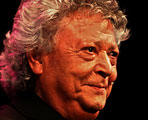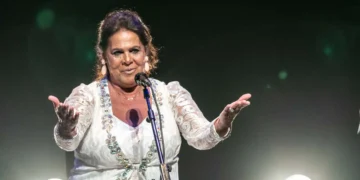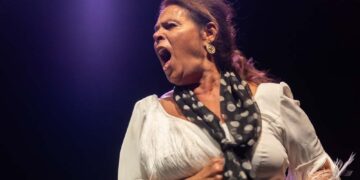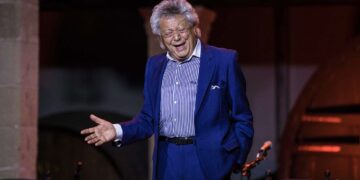Friday, September 28th, 2012. 2300h. Teatro Lope de Vega.
Special 17 Bienal de Flamenco de Sevilla – All the information
Text: Estela Zatania
Photos: La Bienal
“It’s that life is so short…”
(“Es que la vía era mu’ corta…”)
…and the road is so long, but no one knows their fate, just leave me some flowers, leave me, I’m heading for the country to enjoy myself, the country has no doors” [“…y mu’ largo era el camino, pero nadie sabe cual es su sino, dejadme flores, dejadme, que yo voy al campito a divertirme, que el campo no tiene llave”]. That verse, and its peculiar interpretation, is a brilliant piece of twentieth century cante. The highly personalized creation of a singer with one of the biggest personalities of our time: José Cortés Jiménez “Pansequito” (La Línea,1946).
He came to the Bienal de Flamenco de Sevilla to celebrate the fiftieth anniversary of his professional debut, and many flamenco fans of his age felt they were a part of it all, the last hurrah of classic cante before it gets swallowed up in the din of cajons, proposals and politicians. Because Pansequito belongs to that blessed generation of young innovators led by Camarón. Singers who were formed in the shadow and likeness of Caracol and Mairena, but whose need to move forward set them off on new paths, even though their experiments now seem conservative to us in the year 2012.
I like to remember a 1973 interview with Periñaca by my colleague José María Velázquez Gaztelu. It was the beginning of Camarón fever, and the elderly singer says “That Camarón guy, he’s never really going to sing siguiriyas, even being such a big star…you know that other one, what’s his name? Pansequito, that’s it! He has a better sound”. In those days even Periñaca had to take sides, you were either for Camarón, or “the other one”.
I’m going down to the avenue (“Yo me voy a la alamea
and I’m going to sing, y allí me pongo a cantar
that gypsy girl’s eyes los ojos de esta gitana
are more than I can bear no se pueden aguantar
I’m going down to the avenue yo me voy a la alamea
love of my life niña de mi corazón”)
The rest is history. Camarón became a cult figure who left us prematurely, and Pansequito kept to his discreet path, slow and steady, as a star of cante. The singer’s 50th anniversary in flamenco is no time to evaluate his performance last night. Suffice it to say he offered the habitual repertoire sung with his rich voice of antique velvet that gets you from the first moment. Citing something I wrote in regard to his last recording, “Un canto a la libertad” (2009): “There are voices that get you hooked and demand to be listened to. This is one of them.”
The recital was accompanied on guitar by Antonio Higuero and Manuel Valencia (they achieved a beautiful sound playing in A and C position respectively along with piano for the cantiñas), with the violins of David Moreira and José Gregorio Lovera, and the palmas of Rafael el Eléctrico, Rafita and Chícharo.
I remember the day I was going out of a big store on the Rosaleda in Málaga, and from the loudspeakers to the street the voice of Pansequito rang out with his “Tápame” which would go on to make history. I went back into the store to hear better. The guitars of Juan and Pepe Habichuela were launching razor blades of compás to anyone in earshot, and the voice of José Cortés Jiménez changed our way of understanding cante forever.
Last night there were commemorative plaques presented to the singer by famous bullfighters…there was a fiesta ending with Aurora Vargas dancing…there were standing ovations and embraces for the winner of the Córdoba Prize for Creativity 1974, the Compás del Cante of the Fundación Cruzcampo 2010 and the Galardón Calle de Alcalá 2012, among many other honors. Congratulations, maestro, and thank you for this half century of flamenco you’ve given us.
Descubre más desde Revista DeFlamenco.com
Suscríbete y recibe las últimas entradas en tu correo electrónico.





























